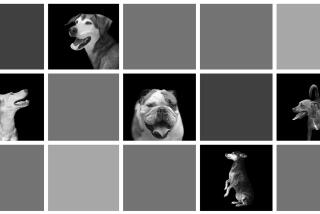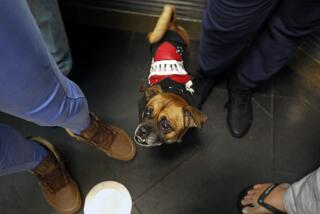BOOK REVIEW : Dogged Research Leads to Gem of a Book : THE HIDDEN LIFE OF DOGS <i> by Elizabeth Marshall Thomas</i> ; Houghton Mifflin Co.; A Peter Davison Book $18.95, 148 pages
- Share via
Before I drove up to the country to pick up my pup (Isabel, now officially the family dog), the breeder asked why I had decided to get a border terrier. (A border terrier is a good-natured, smallish dog with Toto’s face set on a less stubby body.) I told her that, in the entry for border terriers, my guide to dog breeds listed 12 positive characteristics and under negative characteristics, said simply, “None.”
“She’s still a dog,” said the breeder. And though Isabel is one of the finest creatures ever to tread the Earth, a truer word was never said.
We place terrible burdens on dogs. We expect them to distinguish burglars from mail carriers, and to pay more attention to us than any lover ever did. We demand they stay out of the way when we’re busy, yet to always be alert for commands along the lines of, “Lassie, get help.” The lesson of this slightly bizarre gem of a book is that they’re all still just dogs. And they’re more interested in other dogs than they are in us.
Elizabeth Marshall Thomas, an anthropologist, wrote “The Harmless People,” about the !Kung Bushmen of southwest Africa, and “Reindeer Moon,” a novel about Paleolithic hunter-gatherers in Siberia. Readable and deep, “Reindeer Moon” is a sort of “Clan of the Cave Bear” for the more contemplative reader. In “The Hidden Life of Dogs” she hopes to enter dog consciousness. The creatures have been in our lives, she says, for 20,000 years and we haven’t figured out what they want. She records the lives of 11 dogs that have lived with her, including huskies, a dingo, a dingo-spaniel mix and two pugs.
Thomas’ method is more physically rigorous than scientifically rigorous. For two years, two or three nights a week, for example, she’d leap on her bike and follow a Siberian husky, Misha, as he cruised around Greater Boston.
Misha was violating local leash laws, which turned out to be convenient for her research. With complaints about him as her clues, Thomas was able to deduce that Misha had a range of about 130 square miles. Luckily, he was a good navigator, avoiding cars and dog catchers.
Thomas let all her dogs plan how to spend their own time. She considers the Barbara Woodhouse style of obedience training to be brainwashing. After her project began, she writes, “I made no effort to train them, even for housebreaking or coming when called.” The young dogs copied the old dogs, which kept the house clean enough.
Furthermore, “All the dogs naturally came when called most of the time, declining to do so only if our demands conflicted with something that was genuinely important to them. A dog who feels free to make such a distinction shows more of his thoughts and feelings in a single day than a rigidly trained hyper-disciplined dog can show in a lifetime.”
Misha’s behavior revealed that he wasn’t voyaging in search of sex or food; he wanted to check out other dogs and compare himself to them. What Misha and the other dogs showed Thomas is that they want to belong to a stable pack, preferably in its upper echelons. “Every dog might wish to be Dog One, but like us, most dogs want membership in the group even more than they want supremacy over others. . . .”
Misha was very concerned about his image and his place in the informal Greater Boston pack. When Thomas saw him with leg lifted bizarrely high, straining to place a yellow stain on an extremely high snowbank, she realized Misha wanted to give the impression that whoever had made the stain was a giant.
In the wild, high-status males are the ones selected for mating by the females. In a group of wolves, usually only the dominant pair can have a litter, and if there are other litters, only the dominant female gets to give birth inside the den.
Thomas is an unusually strong person. She can watch a wolf pack for 30 hours straight as well as dodge Boston drivers on a bike. She is not a fussy person. When Misha’s mate goes into labor, Thomas writes, “Up and down the stairs she toiled, frantic, weeping, her sides bulging, blood and amniotic fluid soiling her beautiful breeches.” Not much thought about the floor.
When Misha comes to look at the pups, he vomits in front of them. Instead of running for the sponge, Thomas observes that he was telling his mate he would feed her and their pups, by “giving her the food he happened to have with him at the moment. . . .”
Unsentimental, unfussy and learned, Thomas can’t help being interesting in her observations. But there are times when she doesn’t think much about linking her dogs’ experience to the social problems dogs can present.
How do the parents of toddling children or the keepers of exquisite gardens feel when Misha jumps into their back yards? Did Thomas keep a supply of Baggies in her bike basket to clean up after him? What about the hundreds of thousands of people who take a puppy to the animal shelter when he chews shoes or stains the rug? Would four or five obedience classes constitute brainwashing?
Thomas implies that it’s best to have a pack. “Dogs who live in each other’s company are calm and pragmatic, never showing the desperate need to make known their needs and feelings or to communicate their observations, as some hysterical dogs who know only the company of our species are likely to do.” One autumn evening she joins her pack lying on a hillside and shares the wolfish feelings. “Primates feel pure, flat immobility as boredom,” she observes, “but dogs feel it as peace.”
More to Read
Sign up for our Book Club newsletter
Get the latest news, events and more from the Los Angeles Times Book Club, and help us get L.A. reading and talking.
You may occasionally receive promotional content from the Los Angeles Times.









